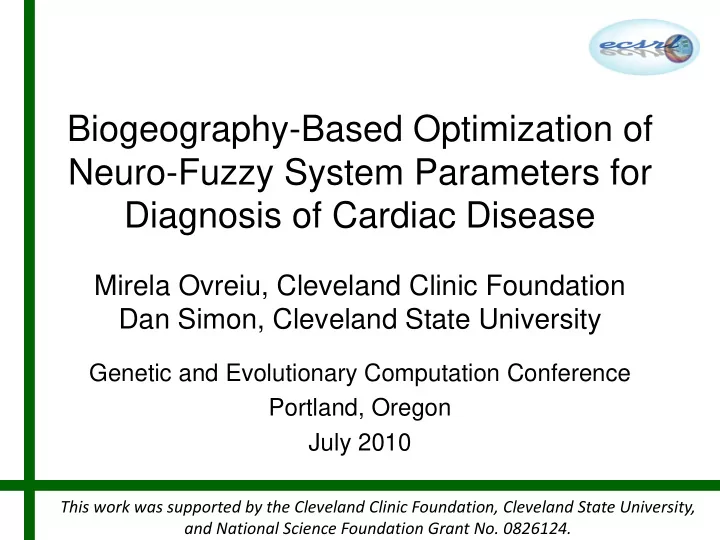

Biogeography-Based Optimization of Neuro-Fuzzy System Parameters for Diagnosis of Cardiac Disease Mirela Ovreiu, Cleveland Clinic Foundation Dan Simon, Cleveland State University Genetic and Evolutionary Computation Conference Portland, Oregon July 2010 This work was supported by the Cleveland Clinic Foundation, Cleveland State University, and National Science Foundation Grant No. 0826124.
Outline 1. Biogeography-Based Optimization (BBO) 2. Opposition Based Learning (OBL) 3. Neuro-Fuzzy Networks 4. Cardiomyopathy 5. Experimental Results 6. Conclusions 2
Biogeography-Based Optimization Species migrate between islands via flotsam, wind, flying, swimming, … 3
Biogeography-Based Optimization As habitatability improves: immigration λ 1. Number of species increases emigration rate 2. Emigration increases: more μ species leave the island 3. Immigration decreases: fewer species enter the island S 1 S 2 S max number of species Migration rates vary with the number of species on an island 4
Biogeography-Based Optimization For each solution H i For each solution feature s Select solution H i with probability λ i If solution H i is selected then Select H k with probability μ k If H k is selected then H i ( s ) ← H k ( s ) end end next solution feature next solution One generation of the BBO algorithm 5
Opposition Based Learning x r (random) x q (random) x c x o “Social revolutions are, compared to progress rate of natural systems, extremely fast changes in human society.” Hamid R. Tizhoosh, 2005 • x = individual in optimization algorithm • x o = opposite individual • x q = quasi-opposite • x r = quasi-reflected opposite 6
Opposition Based Learning x r (random) x q (random) x c x o Prob( x o better than x ) 1/2 Prob( x q better than x ) 9/16 Prob( x r better than x ) 11/16 Prob( x q better than x o ) 11/16 Source: Mehmet Ergezer, Prob( x r better than x o ) 9/16 CSU doctoral student 7
Neuro-Fuzzy Networks m 1 μ 11 ( x 1 ) x 1 z 1 x 2 w x m z p μ pm ( x m ) m p Universal approximation properties pm + pm + p = p (2 m +1) adjustable parameteres 8
Cardiomyopathy • Cardiovascular diseasei s the leading cause of death in the western world – Over 800,000 deaths per year in the United States – One in five Americans has cardiovascular disease • Cardiomyopathy: weakening of the heart muscle • Could be inherited or acquired (unknown cause) • Biochemical considerations show that cardiomyopathy will affect the P wave of an ECG 9
Cardiomyopathy The P wave is at the sub-mV scale. Changes due to cardiomyopathy: • Shape • Amplitude 10
Cardiomyopathy • ECG data collection – Data collected for 24 hours – Average P wave data calculated each minute • Duration • Inflection • Energy • Amplitude – 37 cardiomyopathy patients, 18 control patients 11
Cardiomyopathy Normalized P wave features with 1- σ bars. Data is complex due to its time-varying nature. 12
Experimental Results m 1 μ 11 ( x 1 ) x 1 z 1 x 2 w x m z p μ pm ( x m ) m p 4 inputs: m = 4 p chosen as a tradeoff (training vs. testing) output = +1 for cardiomyopathy and –1 for control 13
Experimental Results Training Error Training CCR Testing CCR p Best Mean Best Mean Best Mean 2 0.85 0.88 76 72 66 58 3 0.77 0.84 82 77 75 62 4 0.78 0.83 84 77 65 55 5 0.78 0.83 82 76 63 58 Training error and correct classification rate (CCR) as a function of the number of middle layer neurons p . 14
Experimental Results Training Error Training CCR Testing CCR Best Mean Best Mean Best Mean BBO 0.77 0.86 84 76 66 58 Q-BBO 0.83 0.86 79 74 69 62 R-BBO 0.80 0.85 81 75 65 60 Training error and correct classification rate (CCR) for BBO and oppositional BBO ( p = 3). 15
Experimental Results Training Error Training CCR Testing CCR Mutation Best Mean Best Mean Best Mean rate (%) 0.1 0.79 0.85 81 76 71 61 0.2 0.82 0.86 80 75 72 59 0.5 0.77 0.85 82 76 69 62 1.0 0.80 0.85 80 74 67 57 2.0 0.83 0.86 79 74 69 62 5.0 0.82 0.87 81 74 68 58 10.0 0.80 0.87 78 73 65 59 Training error and correct classification rate (CCR) for different mutation rates using Q-BBO ( p = 3). 16
Typical Q-OBBO training and test results 17
Experimental Results Success varies from one patient Percent correct to the next. Demographic information needs to be included in the classifier. Patient number 18
Conclusions • Successful feasibility study – BBO for neuro-fuzzy training – Cardiomyopathy classification • Future work – Time varying classification (majority rules) – Inclusion of demographics – Combination with gradient-based training – Product development 19
Recommend
More recommend